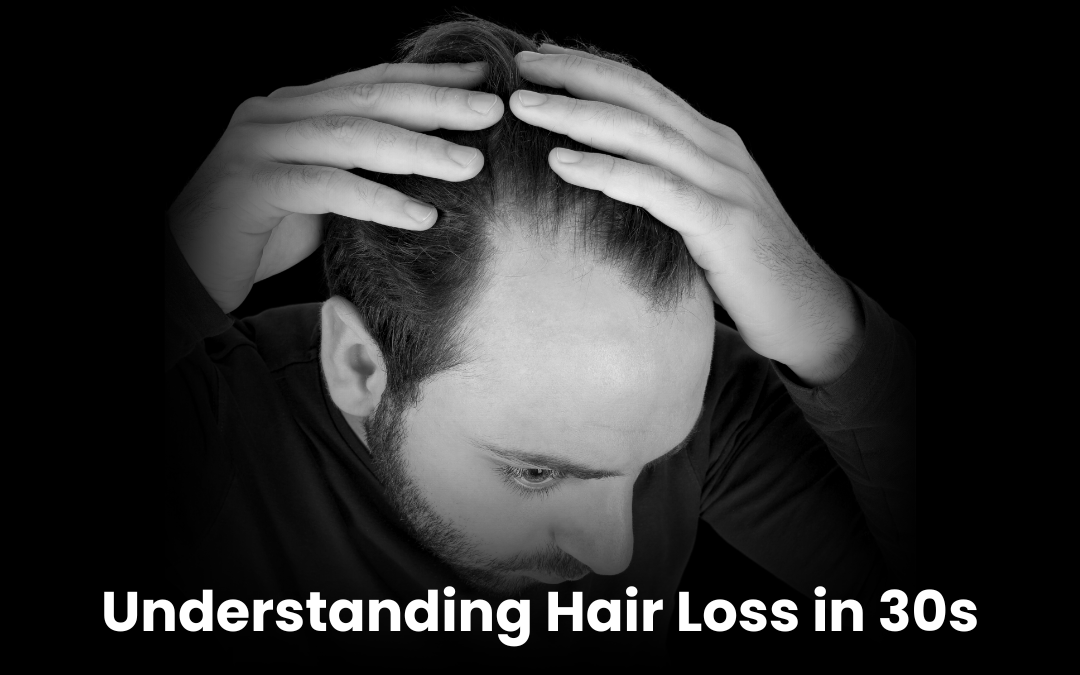Entering your 30s can be a transformative period, filled with personal and professional growth. However, it’s also a time when many individuals begin to notice changes in their hair. Understanding hair loss in 30s is crucial to addressing and managing this common concern.
At QHT Clinic, recognized as one of the best hair transplant clinic in India, we offer expert insights and cutting-edge treatments to help you maintain healthy, confident hair. Join us as we delve into the causes, treatments, and preventative measures to tackle hair loss effectively.

Curious if hair loss at this age is normal? Let’s find out.
Is it normal to have hair loss in your 30s?
Experiencing hair loss in your 30s can be concerning, but it’s a common issue many face. Several factors contribute to hair thinning and loss at this age, including genetics, hormonal changes, stress, and lifestyle habits.
While it might seem alarming, understanding the underlying causes can help you address and manage hair loss effectively. By understanding hair loss in 30s is widespread, you can take proactive steps to maintain a healthy scalp and hair.
Now, let’s look at the various factors that may cause hair loss and balding in 30s.
Common causes of hair loss in 30s
- Genetics: Hair loss is heavily influenced by family history. If your parents or grandparents had hair thinning or baldness, you may also be more likely to experience it.
- Hormonal changes: Hormone fluctuations or thyroid issues can lead to hair loss.
- Stress: High levels of stress can trigger hair loss conditions like telogen effluvium, where hair follicles enter a resting phase and fall out more easily.
- Nutritional deficiencies: A lack of essential vitamins and minerals, such as vitamin D, iron, and biotin, can weaken hair and cause it to fall out.
- Medical conditions: Certain medical conditions, including alopecia areata, scalp infections, and autoimmune diseases, can lead to hair loss.
- Lifestyle factors: Poor diet, smoking, excessive alcohol consumption, and harsh hair treatments can all contribute to hair thinning and loss.
Concerned about hair loss? Consult with a hair specialist to explore personalized solutions and get expert advice tailored to your needs.
Wondering how to spot hair loss early? Look out for these signs.
How to identify early signs of hair loss
Recognizing symptoms:
- Thinning hair: Noticeable reduction in hair volume, often leading to a more visible scalp, which can be an early sign of balding in 30s.
- Receding hairline: Gradual retreat of the hairline, a common indication of male pattern baldness.
- Increased hair shedding: An abnormal amount of hair falling out during brushing or washing.

- Widening part: A noticeable widening of the part in your hair may indicate thinning, particularly in cases of female pattern baldness in 30s.
- Visible scalp: More of the scalp becomes visible as hair density decreases.
- Change in hair texture: Hair may become finer or more brittle, reflecting changes related to hair loss.
Self-assessment tips
- Regular monitoring: Keep track of any changes in your hair density and overall health over time.
- Photographic comparisons: Be aware of how your hair looked in previous photos and compare them to current ones to spot any gradual thinning or receding.
- Check your pillow and hairbrush: Regularly check for an unusual amount of hair on your pillow or in your hairbrush, which can signal increased shedding.

- Pull test: Gently pull a small section of your hair. If more than 10% of the hairs come out, this might be an indication of excessive hair loss.
Noticing hair changes? Start taking control of your hair health today by scheduling an appointment with an experienced hair doctor.
Are you ready to explore your options for combating hair loss? Here are some effective treatments to consider.
Treatment Options
When it comes to addressing hair loss, there are several advanced treatment options available, both surgical and non-surgical:
- FUE (Follicular unit extraction): This technique involves harvesting single hair follicles from a donor site and transplanting them to areas of thinning or baldness. FUE provides natural-looking results with minimal scarring and a quick recovery time.
- QHT (Quick hair transplant): This advanced FUE technique uses ultrafine Cole punches to extract hair grafts, reducing scarring. Precise implantation with SAVA implanters ensures optimal results.

- FUT (Follicular unit transplantation): This traditional method involves removing a scalp strip from the donor area, extracting follicular units, and transplanting them to the recipient site.
- PRP (Platelet-rich plasma therapy): This non-surgical treatment involves injecting your platelet-rich plasma into the scalp to stimulate hair growth and improve hair thickness.
- Medications: FDA-approved medications like minoxidil and finasteride can help slow hair loss and promote hair regrowth for some individuals.
Exploring the right treatment option for you is essential. For personalized advice and expert solutions, consider consulting with one of the best hair transplant clinic in India, like QHT Clinic. They offer a range of advanced treatments tailored to your specific needs, helping you achieve healthier, thicker hair.
Let’s dive into the details about the ways hair loss affects men and women differently in their 30s:
Hair loss in your 30s: Male vs. Female
Hair loss can affect both men and women in their 30s, but the patterns and causes can differ significantly between the genders.
Male hair loss
- Pattern: Men often experience hair loss as a receding hairline and thinning at the crown. This pattern is commonly known as male pattern baldness (androgenetic alopecia).
- Causes: Genetics plays a significant role in hormonal changes, particularly the impact of dihydrotestosterone (DHT), contributing to hair follicle miniaturization.

- Symptoms: A receding hairline, thinning at the temples and crown, and eventually, a horseshoe pattern of hair around the sides and back of the head.
Female hair loss
- Pattern: Women typically experience diffuse thinning across the scalp rather than a receding hairline. This is often referred to as female pattern hair loss.
- Causes: Hormonal changes due to childbirth, pregnancy, menopause, and conditions like PCOS can trigger hair loss. Genetics also plays a role.
- Symptoms: Overall thinning of the hair, widening of the part line, and sometimes thinning at the crown.
Want to take control of hair loss through simple lifestyle changes? Here are some effective tips.
Lifestyle changes to prevent hair loss
- Balanced diet: Include essential nutrients like proteins, vitamins, and minerals in your diet to support hair health.
- Regular exercise: Improve blood circulation to your scalp with physical activity, promoting healthy hair growth.
- Stress management: Reduce stress with yoga, meditation, or hobbies to prevent stress-induced hair loss.

- Proper hair care: Avoid harsh treatments and heat styling. Use gentle hair care products and avoid over-washing.
- Adequate sleep: Get 7-8 hours of quality sleep to support overall health, including your hair.
- Hydration: Drink plenty of water to keep your body and scalp hydrated.
- Avoid smoking and excessive alcohol: These habits can impair blood circulation and nutrient absorption, contributing to hair loss.
Consult a hair transplant specialist and embark on your journey to luscious, vibrant hair today!
Wondering if it’s time to seek professional help? Here are some signs to watch for.
When to consult a doctor?
- Rapid or severe hair loss: Significant thinning or sudden shedding warrants a professional evaluation.
- Persistent scalp issues: Ongoing problems like itching, redness, or inflammation should be assessed.
- Accompanying symptoms: Hair loss with symptoms such as weight changes or fatigue needs a doctor’s attention.

- Family history: If hair loss is common in your family and you are noticing it yourself, consider consulting a specialist.
- Ineffective treatments: If over-the-counter products haven’t worked, seek expert advice.
- Emotional impact: Significant emotional distress from hair loss is a valid reason to consult a healthcare provider.
Conclusion
Managing and understanding hair loss in 30s involves recognizing its causes and taking proactive steps. By adopting a balanced lifestyle, exploring advanced treatments, and seeking professional advice, you can effectively address hair loss and maintain healthier hair. With the right approach, you can navigate this common concern and work towards sustaining your hair’s health and vitality.
FAQ’s
How to prevent hair loss in 30s?
To prevent hair loss in your 30s, maintain a balanced diet, manage stress effectively, and practice proper hair care. Regularly consult with a specialist for personalized advice.
How can I stop balding in my 30s?
To stop balding in your 30s, explore medical treatments, maintain a healthy lifestyle, and consult a specialist for personalized solutions.
How do I know if I’m a candidate for hair transplant surgery in my 30s?
You might be a candidate for hair transplant surgery if you have:
- Significant hair loss
- Stable hair loss patterns
- Healthy donor area
Consult a specialist for a detailed evaluation and personalized recommendation.

